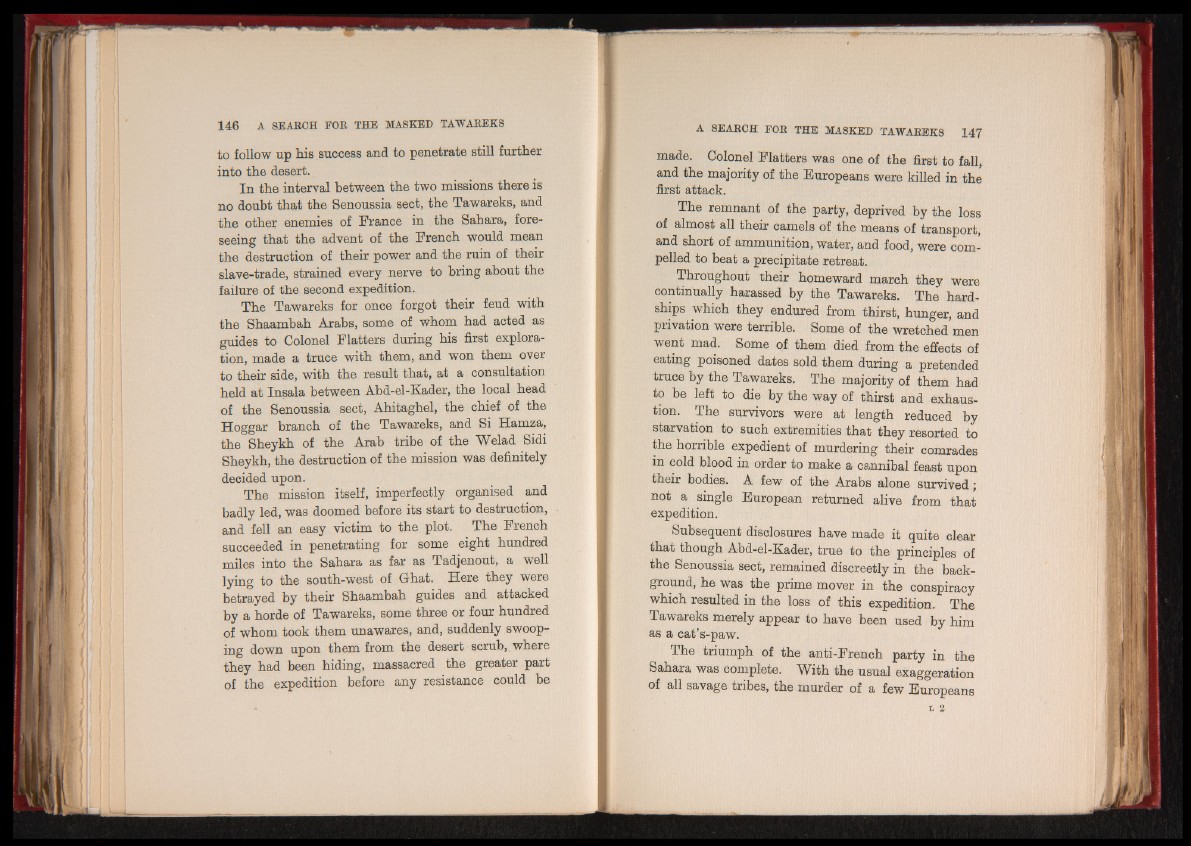
to follow up his success and to penetrate still further
into the desert.
In the interval between the two missions there is
no doubt that the Senoussia sect, the Tawareks, and
the other enemies of France in the Sahara, foreseeing
that the advent of the French would mean
the destruction of their power and the ruin of their
slave-trade, strained every nerve to bring about the
failure of the second expedition.
The Tawareks for once forgot their feud with
the Shaambah Arabs, some of whom had acted as
guides to Colonel Flatters during his first exploration,
made a truce with them, and won them over
to their side, with the result that, at a consultation
held at Insala between Abd-el-Kader, the local head
of the Senoussia sect, Ahitaghel, the chief of the
Hoggar branch of the Tawareks, and Si Hamza,
the Sheykh of the Arab tribe of the Welad Sidi
Sheykh, the destruction of the mission was definitely
decided upon.
The mission itself, imperfectly organised and
badly led, was doomed before its start to destruction,
and fell an easy victim to the plot. The French
succeeded in penetrating for some eight hundred
miles into the Sahara as far as Tadjenout, a well
lying to the south-west of Ghat. Here they were
betrayed by their Shaambah guides and attacked
by a horde of Tawareks, some three or four hundred
of whom took them unawares, and, suddenly swooping
down upon them from the desert scrub, where
they had been hiding, massacred the greater part
of the expedition before any resistance could be
made. Colonel Flatters was one of the first to fall,
and the majority of the Europeans were killed in the
first attack.
The remnant of the party, deprived by the loss
of almost all their camels of the means of transport,
and short of ammunition, water, and food, were compelled
to beat a precipitate retreat.
Throughout their homeward march they were
continually harassed by the Tawareks. The hardships
which they endured from thirst, hunger, and
privation were terrible. Some of the wretched men
went mad. Some of them died from the effects of
eating poisoned dates sold them during a pretended
truce by the Tawareks. The majority of them had
to be left to die by the way of thirst and exhaustion.
The survivors were at length reduced by
starvation to such extremities that they resorted to
the horrible expedient of murdering their comrades
in cold blood in order to make a cannibal feast upon
their bodies. A few of the Arabs alone survived ;
not a single European returned alive from that
expedition.
Subsequent disclosures have made it quite clear
that though Abd-el-Kader, true to the principles of
the Senoussia sect, remained discreetly in the background,
he was the prime mover in the conspiracy
which resulted in the loss of this expedition. The
Tawareks merely appear to have been used by him
as a cat’s-paw.
The triumph of the anti-French party in the
Sahara was complete. With the usual exaggeration
of all savage tribes, the murder of a few Europeans